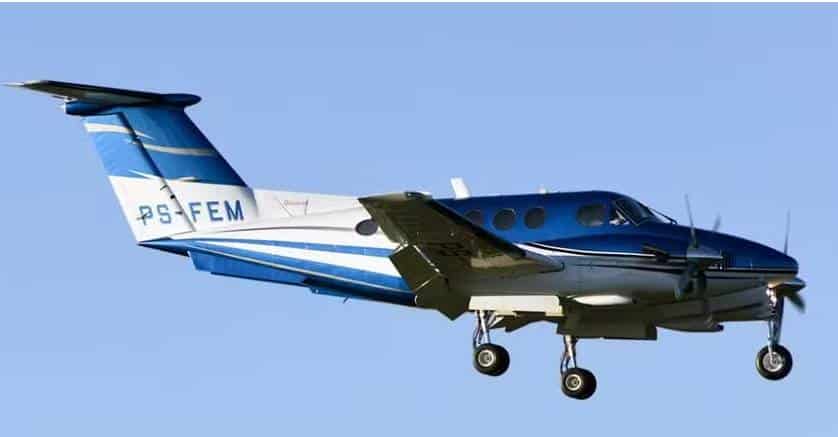King Air F90 Plane Crashes in Barra Funda, Explodes and Leaves Dead and Injured in São Paulo
A King Air F90 aircraft crashed on the morning of Friday, February 7, 2025, on Avenida Marquês de São Vicente, in the western zone of São Paulo, causing destruction and panic in the area. The aircraft, which took off from Campo de Marte Airport bound for Porto Alegre, experienced technical issues shortly after takeoff and attempted an emergency landing, which was unsuccessful. Upon impact, the plane struck a bus and exploded, creating a fireball visible from miles away. The accident resulted in two confirmed deaths and two injuries, including a motorcyclist and the bus driver. Traffic in the area was completely blocked to allow for rescue and investigation efforts.
The crash site was described as chaotic, with debris scattered across the avenue and emergency teams working to extinguish the flames and assist the victims. Seven fire department vehicles were dispatched to the location. The thick black smoke reduced visibility, while witnesses reported hearing a loud explosion at the moment of impact. Security camera footage captured the exact moment of the crash and the subsequent explosion.
Investigations into the cause of the accident have already begun, with teams from the Brazilian Air Force (FAB) and the Center for Investigation and Prevention of Aeronautical Accidents (CENIPA) analyzing the aircraft’s wreckage. Technicians from the National Civil Aviation Agency (ANAC) are also involved in the process, reviewing the aircraft’s maintenance history and the pilot’s flight experience.

King Air F90 Features and Its Operation in Brazil
The Beechcraft King Air F90 is part of the renowned King Air family, manufactured by Beechcraft since the 1960s. The F90 model was introduced in the late 1970s, combining features from the King Air 90 and 200 models, offering greater power and range. Equipped with two Pratt & Whitney PT6-A-135 engines, it has a range of approximately 1,330 nautical miles and a cruising speed of about 270 knots.
With seating for up to eight passengers and a pressurized cabin, the King Air F90 is widely used for executive transport, medical evacuation services, and air taxi operations. Its internal configuration provides a comfortable flight, with club-style seating arrangements and onboard luggage compartments accessible in-flight. In Brazil, this aircraft is commonly used by business executives, politicians, and professionals who require fast travel between cities.
Flight Path and Emergency Landing Attempt
The aircraft took off at 7:15 AM from Campo de Marte Airport, a hub for executive aviation in São Paulo. A few minutes into the flight, the pilot reported technical failures to air traffic control and attempted to return to the airport. However, due to a loss of altitude, the only option was to find a suitable location for an emergency landing. Avenida Marquês de São Vicente, one of the main roads in the western zone of São Paulo, was chosen for the maneuver, which ultimately failed.
Witnesses reported that the aircraft struck a tree before hitting the ground, which may have further compromised the landing attempt. Debris was scattered in multiple directions, hitting vehicles and pedestrians nearby. The explosion from the impact set the bus on fire, requiring firefighters to act quickly to contain the flames.

Technical Data on the Aircraft and Impact of the Crash
- Model: Beechcraft King Air F90
- Engines: 2x Pratt & Whitney PT6-A-135
- Capacity: 7 to 9 passengers + 1 pilot
- Cruising Speed: 270 knots
- Range: 1,330 nautical miles
- Maximum Takeoff Weight: 10,950 lbs
- Dimensions:
- Wingspan: 13.9 meters
- Length: 12.1 meters
- Height: 4.6 meters
Rescue Efforts and Road Closures
As soon as the accident was reported, teams from the São Paulo Fire Department and Military Police were mobilized to Avenida Marquês de São Vicente. Seven fire department units were sent to the scene to control the fire and assist the injured. Traffic in the area was completely blocked, causing congestion on parallel streets.
The São Paulo Transport Authority (SPTrans) confirmed that the bus involved belonged to the Santa Brígida bus company and had no passengers at the time of the crash. The driver was injured but managed to escape the vehicle before the flames spread. A motorcyclist passing through the area was hit by debris and also required medical attention. Both were taken to nearby hospitals, but their conditions remain unknown.
History of King Air Accidents in Brazil
The King Air aircraft is widely used in Brazil and has been involved in several high-profile accidents. One of the most notable incidents was the crash of a King Air C90 in 2014 on the coast of São Paulo, which resulted in the death of then-presidential candidate Eduardo Campos. Another accident occurred in 2021 in the interior of Minas Gerais, where a King Air B200 crashed shortly after takeoff, killing all onboard.
Investigations into such accidents typically take months, as they involve a thorough analysis of the aircraft’s fuselage, engines, cockpit recordings, and communication with air traffic control. In the case of the King Air F90 that crashed in Barra Funda, initial findings point to mechanical failure, but the possibility of human error or operational failure has not yet been ruled out.
Safety Measures and Impact on Executive Aviation
Following the accident, Brazilian aviation authorities have reinforced the need for stricter inspections of small aircraft. Although the King Air F90 is a reliable model, it has been in production for over 40 years, requiring frequent maintenance to ensure safe operation.
The accident also reignited discussions about aircraft operations in urban areas. Campo de Marte Airport, where the King Air F90 took off, is located in one of São Paulo’s most densely populated regions, increasing the risk of incidents involving executive aviation. Experts stress the need for additional safety measures to prevent similar tragedies in the future.
Timeline of the Crash
- 7:15 AM – Takeoff from Campo de Marte Airport bound for Porto Alegre
- 7:18 AM – Pilot reports mechanical failure and attempts to return to the airport
- 7:20 AM – Aircraft loses altitude and attempts an emergency landing on Avenida Marquês de São Vicente
- 7:21 AM – Impact with bus and explosion; witnesses report a loud blast and fire
- 7:25 AM – First fire department units arrive at the scene
- 8:00 AM – Traffic in the area is completely blocked for investigations


A King Air F90 aircraft crashed on the morning of Friday, February 7, 2025, on Avenida Marquês de São Vicente, in the western zone of São Paulo, causing destruction and panic in the area. The aircraft, which took off from Campo de Marte Airport bound for Porto Alegre, experienced technical issues shortly after takeoff and attempted an emergency landing, which was unsuccessful. Upon impact, the plane struck a bus and exploded, creating a fireball visible from miles away. The accident resulted in two confirmed deaths and two injuries, including a motorcyclist and the bus driver. Traffic in the area was completely blocked to allow for rescue and investigation efforts.
The crash site was described as chaotic, with debris scattered across the avenue and emergency teams working to extinguish the flames and assist the victims. Seven fire department vehicles were dispatched to the location. The thick black smoke reduced visibility, while witnesses reported hearing a loud explosion at the moment of impact. Security camera footage captured the exact moment of the crash and the subsequent explosion.
Investigations into the cause of the accident have already begun, with teams from the Brazilian Air Force (FAB) and the Center for Investigation and Prevention of Aeronautical Accidents (CENIPA) analyzing the aircraft’s wreckage. Technicians from the National Civil Aviation Agency (ANAC) are also involved in the process, reviewing the aircraft’s maintenance history and the pilot’s flight experience.

King Air F90 Features and Its Operation in Brazil
The Beechcraft King Air F90 is part of the renowned King Air family, manufactured by Beechcraft since the 1960s. The F90 model was introduced in the late 1970s, combining features from the King Air 90 and 200 models, offering greater power and range. Equipped with two Pratt & Whitney PT6-A-135 engines, it has a range of approximately 1,330 nautical miles and a cruising speed of about 270 knots.
With seating for up to eight passengers and a pressurized cabin, the King Air F90 is widely used for executive transport, medical evacuation services, and air taxi operations. Its internal configuration provides a comfortable flight, with club-style seating arrangements and onboard luggage compartments accessible in-flight. In Brazil, this aircraft is commonly used by business executives, politicians, and professionals who require fast travel between cities.
Flight Path and Emergency Landing Attempt
The aircraft took off at 7:15 AM from Campo de Marte Airport, a hub for executive aviation in São Paulo. A few minutes into the flight, the pilot reported technical failures to air traffic control and attempted to return to the airport. However, due to a loss of altitude, the only option was to find a suitable location for an emergency landing. Avenida Marquês de São Vicente, one of the main roads in the western zone of São Paulo, was chosen for the maneuver, which ultimately failed.
Witnesses reported that the aircraft struck a tree before hitting the ground, which may have further compromised the landing attempt. Debris was scattered in multiple directions, hitting vehicles and pedestrians nearby. The explosion from the impact set the bus on fire, requiring firefighters to act quickly to contain the flames.

Technical Data on the Aircraft and Impact of the Crash
- Model: Beechcraft King Air F90
- Engines: 2x Pratt & Whitney PT6-A-135
- Capacity: 7 to 9 passengers + 1 pilot
- Cruising Speed: 270 knots
- Range: 1,330 nautical miles
- Maximum Takeoff Weight: 10,950 lbs
- Dimensions:
- Wingspan: 13.9 meters
- Length: 12.1 meters
- Height: 4.6 meters
Rescue Efforts and Road Closures
As soon as the accident was reported, teams from the São Paulo Fire Department and Military Police were mobilized to Avenida Marquês de São Vicente. Seven fire department units were sent to the scene to control the fire and assist the injured. Traffic in the area was completely blocked, causing congestion on parallel streets.
The São Paulo Transport Authority (SPTrans) confirmed that the bus involved belonged to the Santa Brígida bus company and had no passengers at the time of the crash. The driver was injured but managed to escape the vehicle before the flames spread. A motorcyclist passing through the area was hit by debris and also required medical attention. Both were taken to nearby hospitals, but their conditions remain unknown.
History of King Air Accidents in Brazil
The King Air aircraft is widely used in Brazil and has been involved in several high-profile accidents. One of the most notable incidents was the crash of a King Air C90 in 2014 on the coast of São Paulo, which resulted in the death of then-presidential candidate Eduardo Campos. Another accident occurred in 2021 in the interior of Minas Gerais, where a King Air B200 crashed shortly after takeoff, killing all onboard.
Investigations into such accidents typically take months, as they involve a thorough analysis of the aircraft’s fuselage, engines, cockpit recordings, and communication with air traffic control. In the case of the King Air F90 that crashed in Barra Funda, initial findings point to mechanical failure, but the possibility of human error or operational failure has not yet been ruled out.
Safety Measures and Impact on Executive Aviation
Following the accident, Brazilian aviation authorities have reinforced the need for stricter inspections of small aircraft. Although the King Air F90 is a reliable model, it has been in production for over 40 years, requiring frequent maintenance to ensure safe operation.
The accident also reignited discussions about aircraft operations in urban areas. Campo de Marte Airport, where the King Air F90 took off, is located in one of São Paulo’s most densely populated regions, increasing the risk of incidents involving executive aviation. Experts stress the need for additional safety measures to prevent similar tragedies in the future.
Timeline of the Crash
- 7:15 AM – Takeoff from Campo de Marte Airport bound for Porto Alegre
- 7:18 AM – Pilot reports mechanical failure and attempts to return to the airport
- 7:20 AM – Aircraft loses altitude and attempts an emergency landing on Avenida Marquês de São Vicente
- 7:21 AM – Impact with bus and explosion; witnesses report a loud blast and fire
- 7:25 AM – First fire department units arrive at the scene
- 8:00 AM – Traffic in the area is completely blocked for investigations












Post Comment